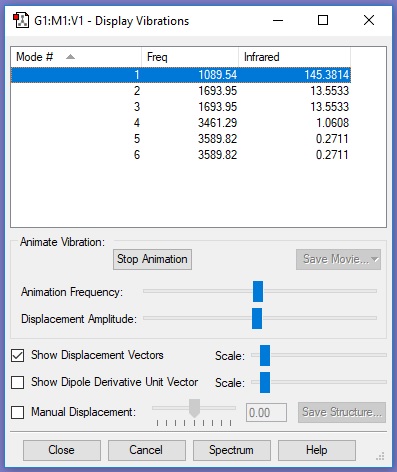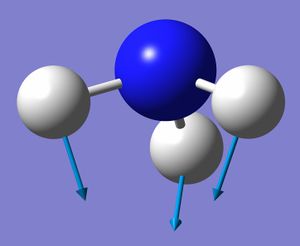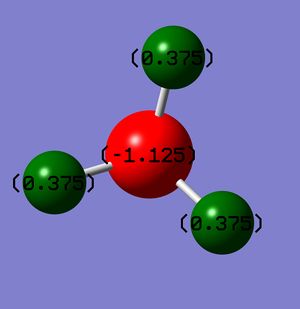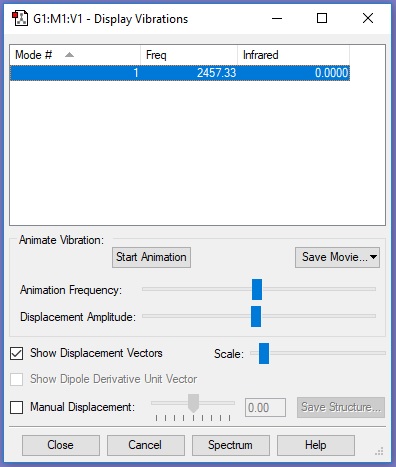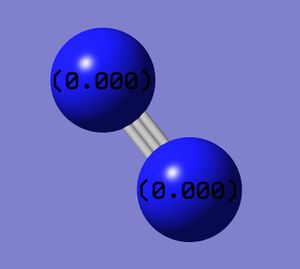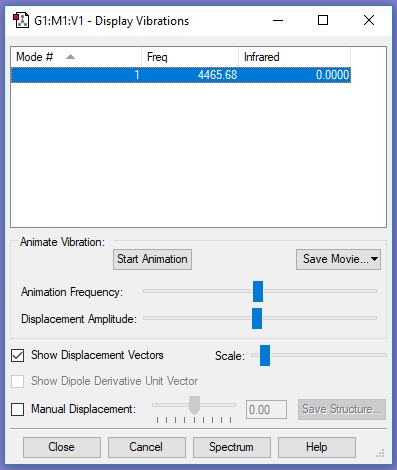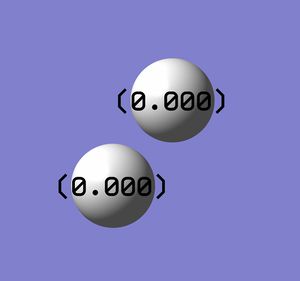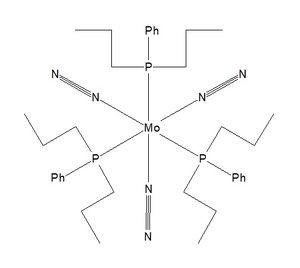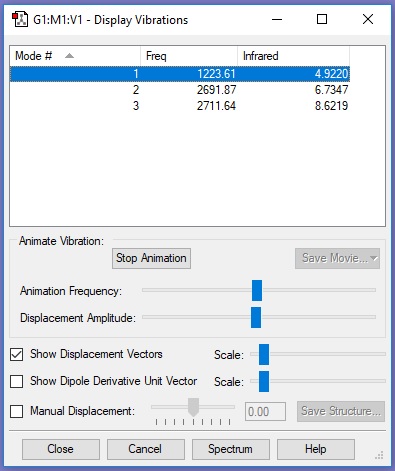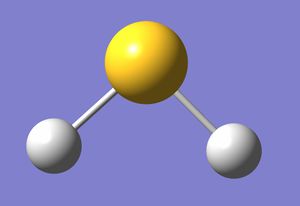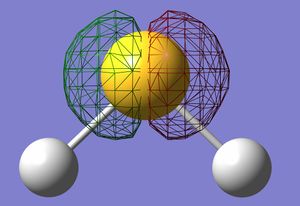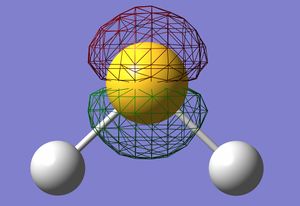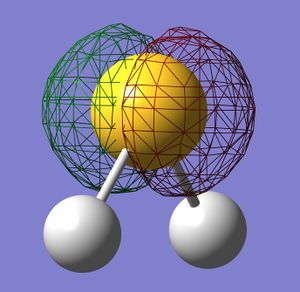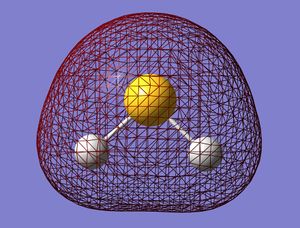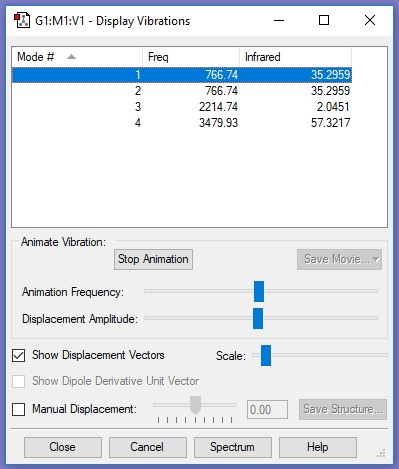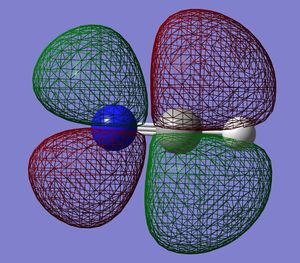Rep:Mod:01531254
NH3 molecule
Results summary
| Molecule name | NH3 |
| Calculation method | RB3LYP |
| Basis set | 6-31G(d,p) |
| E(RB3LYP) | -56.55776873 a.u. |
| RMS Gradient | 0.00000485 a.u. |
| Point group | C3V |
| N-H bond distance | 1.01798 Å |
| H-N-H bond angle | 105.741° |
Item table
Item Value Threshold Converged? Maximum Force 0.000004 0.000450 YES RMS Force 0.000004 0.000300 YES Maximum Displacement 0.000072 0.001800 YES RMS Displacement 0.000035 0.001200 YES
Dynamic Image
Ammonia |
Link to complete NH3 optimisation
The optimisation file is linked to here
Vibrational analysis
Note that the wavenumbers and intensities are only accurate to integer values
| Mode | Frequency | Infrared |
| 1 | 1090 | 145 |
| 2 | 1694 | 14 |
| 3 | 1694 | 14 |
| 4 | 3461 | 1 |
| 5 | 3590 | 0 |
| 6 | 3590 | 0 |
From the 3N-6 rule, 6 modes are expected -> 3(4)-6=6
Modes 2 and 3 are degenerate, and modes 5 and 6 are degenerate
Modes 1, 2 and 3 are bends, while modes 4, 5 and 6 are stretches
Mode 4 is highly symmetric
Mode 1 is known as the "umbrella" mode
In an experimental spectrum of gaseous ammonia, 2 bands would be expected
Charge analysis
The charge on the nitrogen atom is -1.125, while the charge on each of the hydrogen atoms is 0.375
The charge on the nitrogen is negative because it is more electronegative so has higher electron density
The formal charges on each of the atoms in ammonia is 0
Formal Charge = (number of valence electrons) – [(number of electrons in lone pairs) + (half the number of bonding electrons)]
N2 molecule
Results summary
| Molecule name | N2 |
| Calculation method | RB3LYP |
| Basis set | 6-31G(d,p) |
| E(RB3LYP) | -109.52412868 a.u. |
| RMS Gradient | 0.00000060 a.u. |
| Point group | D*H |
| N≡N bond distance | 1.10550 Å |
Item table
Item Value Threshold Converged? Maximum Force 0.000001 0.000450 YES RMS Force 0.000001 0.000300 YES Maximum Displacement 0.000000 0.001800 YES RMS Displacement 0.000000 0.001200 YES
Dynamic Image
Nitrogen Molecule |
Link to complete N2 optimisation
The optimisation file is linked to here
Vibrational analysis
Note that the wavenumbers and intensities are only accurate to integer values
| Mode | Frequency | Infrared |
| 1 | 2457 | 0 |
Charge analysis
The charge on both nitrogens is zero
H2 molecule
Results summary
| Molecule name | H2 |
| Calculation method | RB3LYP |
| Basis set | 6-31G(d,p) |
| E(RB3LYP) | -1.17853936 a.u. |
| RMS Gradient | 0.00000017 a.u. |
| Point group | D*H |
| H-H bond distance | 0.74279 Å |
Item table
Item Value Threshold Converged? Maximum Force 0.000000 0.000450 YES RMS Force 0.000000 0.000300 YES Maximum Displacement 0.000000 0.001800 YES RMS Displacement 0.000001 0.001200 YES
Dynamic Image
Hydrogen Molecule |
Link to complete H2 optimisation
The optimisation file is linked to here
Vibrational analysis
Note that the wavenumbers and intensities are only accurate to integer values
| Mode | Frequency | Infrared |
| 1 | 4466 | 0 |
Charge analysis
The charge on both hydrogens is zero
Mono-Metallic Transition Metal Complex
mer-tris(Dinitrogen)-tris(di-n-propyl-phenylphosphine)-molybdenum is a mono-metallic transition metal complex which coordinates N2
It has the chemical formula C36H57MoN6P3 and the CSD Refcode CILSEV
The N≡N triple bonds have bond lengths of 1.09(2), 1.12(5) and 1.10(4) Å
The bond lengths of the N≡N triple bonds in the complex are approximately the same as the length found in the N2 molecule, around 1.10550 Å
The bonds may differ slightly in length due to the fact that the transition metal complex is in the solid state while the nitrogen is a gas
Furthermore, in the transition metal complex the electron densities of the nitrogen are different than in the nitrogen molecule, affecting bond length
This complex was first recorded in the Journal of the Chemical Society, Chemical Communications, by authors S.N.Anderson, D.L.Hughes and R.L.Richards[1]
Further information about the molecule can be found in the Cambridge Crystallographic Data Centre (direct link to molecule here[2])
Haber-Bosch
The Haber-Bosch process converts hydrogen and nitrogen to ammonia through the following reaction:
N2 + 3H2 -> 2NH3
It is possible to determine the energy for this reaction
E(NH3) = -56.55776873 a.u.
2*E(NH3) = -113.1155375 a.u.
E(N2) = -109.52412868 a.u.
E(H2) = -1.17853936 a.u.
3*E(H2) = -3.53561808 a.u.
ΔE = 2*E(NH3) - [E(N2) + 3*E(H2)] = -0.05579074 a.u.
0.000038 a.u. = 0.1 kJ/mol
ΔE = -146.8 kJ/mol (1dp)
The fact that the enthalpy change is negative indicates that the forward reaction is exothermic
Exothermic reactions are more inclined to occur than endothermic reactions (i.e. the backwards reaction), therefore it can be seen that the ammonia product is more stable than the than the gaseous reactants
SH2 Molecule
Results summary
| Molecule name | SH2 |
| Calculation method | RB3LYP |
| Basis set | 6-31G(d,p) |
| E(RB3LYP) | -399.39162414 a.u. |
| RMS Gradient | 0.00012068 a.u. |
| Point group | C2V |
| S-H bond distance | 1.34737 Å |
| H-S-H bond angle | 92.681° |
Item table
Item Value Threshold Converged? Maximum Force 0.000175 0.000450 YES RMS Force 0.000145 0.000300 YES Maximum Displacement 0.000472 0.001800 YES RMS Displacement 0.000386 0.001200 YES
Dynamic Image
Hydrogen Sulfide |
Link to complete SH2 optimisation
The optimisation file is linked to here
Vibrational analysis
Note that the wavenumbers and intensities are only accurate to integer values
| Mode | Frequency | Infrared |
| 1 | 1224 | 5 |
| 2 | 2692 | 7 |
| 3 | 2712 | 9 |
From the 3N-6 rule, 3 modes are expected -> 3(3)-6=3
None of the modes are degenerate
Mode 1 is a bend, while modes 2 and 3 are stretches
In an experimental spectrum of gaseous hydrogen cyanide, 3 bands would be expected
Charge analysis
The charge on the sulfur is -0.312, while the charge on each of the hydrogens is 0.156
The formal charge each of the atoms in hydrogen sulfide is zero
Formal Charge = (number of valence electrons) – [(number of electrons in lone pairs) + (half the number of bonding electrons)]
Molecular orbitals
Molecular Orbital 1
This molecular orbital comes from the 1s atomic orbitals
It has an energy of -88.88741, so is very deep in energy
Due to this, it doen't have an effect on bonding
This MO is occupied by two electrons
Molecular Orbital 2
This molecular orbital comes from the 2s atomic orbital on the sulphur
It has an energy of -7.95115, and is deep in energy
Due to this, it doen't have an effect on bonding
This MO is occupied by two electrons
Molecular Orbital 3
This molecular orbital comes from a 2p atomic orbital on the sulphur
It has an energy of -5.91588, and is deep in energy
Due to this, it doen't have an effect on bonding
This MO is occupied by two electrons
Molecular Orbital 4
This molecular orbital comes from a 2p atomic orbital on the sulphur
It has an energy of -5.91268, and is deep in energy
Due to this, it doen't have an effect on bonding
This MO is occupied by two electrons
Molecular Orbital 5
This molecular orbital comes from a 2p atomic orbital on the sulphur
It has an energy of -5.90552, and is deep in energy
Due to this, it doen't have an effect on bonding
This MO is occupied by two electrons
Molecular Orbital 6
This molecular orbital comes the sulphur 3s and hydrogen 1s atomic orbitals
It is a bonding molecular orbital
It has an energy of -0.74654, so is in the HOMO/LUMO region of energy
Due to this, it does have an effect on bonding
This MO is occupied by two electrons
Molecular Orbital 7
This molecular orbital comes from the the sulphur 3p and hydrogen 1s atomic orbitals
It is an anti-bonding molecular orbital
It has an energy of -0.44963, so is in the HOMO/LUMO region of energy
Due to this, it does have an effect on bonding
This MO is occupied by two electrons
HCN molecule
Results summary
| Molecule name | HCN |
| Calculation method | RB3LYP |
| Basis set | 6-31G(d,p) |
| E(RB3LYP) | -93.42458132 a.u. |
| RMS Gradient | 0.00017006 a.u. |
| Point group | C*V |
| C-H bond distance | 1.06862 Å |
| C-N bond distance | 1.15702 Å |
| H-C-N bond angle | 180.000° |
Item table
Item Value Threshold Converged? Maximum Force 0.000370 0.000450 YES RMS Force 0.000255 0.000300 YES Maximum Displacement 0.000676 0.001800 YES RMS Displacement 0.000427 0.001200 YES
Dynamic Image
Hydrogen Cyanide |
Link to complete HCN optimisation
The optimisation file is linked to here
Vibrational analysis
Note that the wavenumbers and intensities are only accurate to integer values
| Mode | Frequency | Infrared |
| 1 | 767 | 35 |
| 2 | 767 | 35 |
| 3 | 2215 | 2 |
| 4 | 3480 | 57 |
From the 3N-6 rule, 3 modes are expected -> 3(3)-6=3
Modes 1 and 2 are degenerate
Modes 1 and 2 are bends, while modes 3 and 4 are stretches
In an experimental spectrum of gaseous hydrogen cyanide, 3 bands would be expected
Charge analysis
The charge on the hydrogen atom is 0.234, the charge on the carbon atom is 0.073, and the charge on the nitrogen atom is -0.308
The formal charges on each of the atoms in hydrogen cyanide is zero
Formal Charge = (number of valence electrons) – [(number of electrons in lone pairs) + (half the number of bonding electrons)]
Molecular orbitals
HOMO
The highest occupied molecular orbital has an energy of -0.35939
LUMO
The lowest unoccupied molecular orbital has an energy of 0.01929
References
Marking
Note: All grades and comments are provisional and subjecct to change until your grades are officially returned via blackboard. Please do not contact anyone about anything to do with the marking of this lab until you have recieved your grade from blackboard.
Wiki structure and presentation 1/1
Is your wiki page clear and easy to follow, with consistent formatting?
YES
Do you effectively use tables, figures and subheadings to communicate your work?
YES
NH3 1/1
Have you completed the calculation and given a link to the file?
YES
Have you included summary and item tables in your wiki?
YES
Have you included a 3d jmol file or an image of the finished structure?
YES
Have you included the bond lengths and angles asked for?
YES
Have you included the “display vibrations” table?
YES
Have you added a table to your wiki listing the wavenumber and intensity of each vibration?
YES
Did you do the optional extra of adding images of the vibrations?
YES
Have you included answers to the questions about vibrations and charges in the lab script?
YES, however you did miss out explaining exactly why only 2 modes are seen in the vibrational section. You correctly stated that there are two sets of degenerate modes - this explains a spectrum with 4 peaks. However there are only 2 peaks visible as peaks 4, 5 and 6 are of too low an intensity to be visible.
N2 and H2 0.5/0.5
Have you completed the calculations and included all relevant information? (summary, item table, structural information, jmol image, vibrations and charges)
YES, you could have explained that the charges are 0 as the electronegativities are equal.
Crystal structure comparison 0.5/0.5
Have you included a link to a structure from the CCDC that includes a coordinated N2 or H2 molecule?
YES
Have you compared your optimised bond distance to the crystal structure bond distance?
YES
Haber-Bosch reaction energy calculation 1/1
Have you correctly calculated the energies asked for? ΔE=2*E(NH3)-[E(N2)+3*E(H2)]
YES
Have you reported your answers to the correct number of decimal places?
YES
Do your energies have the correct +/- sign?
YES
Have you answered the question, Identify which is more stable the gaseous reactants or the ammonia product?
YES
Your choice of small molecule 3.5/5
Have you completed the calculation and included all relevant information?
YES - however you have written hydrogen cyanide instead of hydrogen sulfide.
Have you added information about MOs and charges on atoms?
You have done a good job of presenting this information, well done! You could have explained the charges using an electronegativity argument. Also you could have explained that MO6 increases the bonding between the atoms. MO7 is actually a bonding MO between the sulpher 3p and hydrogen 1s, the node in the p orbital doesn't mean it is not a bonding interaction.
Independence 1/1
If you have finished everything else and have spare time in the lab you could: Check one of your results against the literature, or Do an extra calculation on another small molecule, or
YES - well done!
Do some deeper analysis on your results so far

